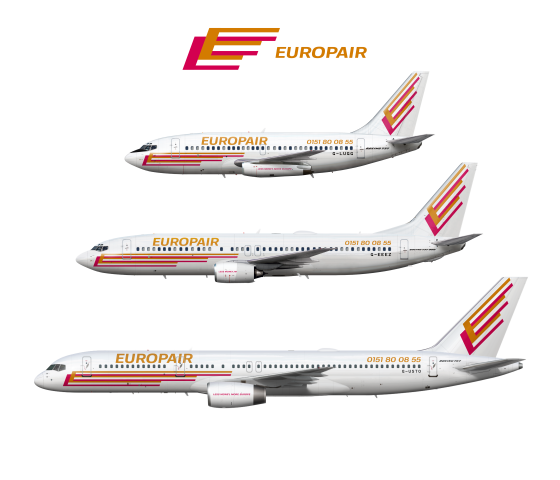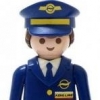Europair Poster
- Owner: Rigel (View all images and albums)
- Uploaded: Apr 07 2024 09:37 AM
- Views: 341
- Album Showroom
Templates By Med/FlyHigh/Brent Mooney/M31MK. All of the other things by Rigel

Europair was a small British low-cost carrier, based at Manchester International Airport. Founded on 14th April, 1991, the company set about launching services all the way across the continent, with the aim of providing a lower-fare, fewer-frills alternative to the major players on the airline scene at the time, evident by the company's tagline, "Less Money, More Europe".
The airline maintained an all-Boeing fleet throughout its history. Used Boeing 737-200s were the first members of the fleet, swept up for cheap prices as European carriers dropped them off in the 1990s to be replaced by next-gen narrowbodies. In total, Europair acquired 9 Boeing 737-200s, which were reconfigured to a new, dense all-economy configuration of 128 seats, nearly the exit limit for the plane. These aircraft were then immediately pressed into service across the United Kingdom, connecting Manchester with places like London, Bristol and Birmingham. The service proved popular quite quickly, with the airline's low fares and friendly staff being a hit with customers.
Keeping the trend going, new, larger aircrafft were sought to be acquired to increase capacity and improve profits. Subsequently, a quartet of Boeing 737-800s were initially ordered, with the airline keen to add more to the fleet in due course. The more capable -800s were put into service on some of the airline's first international destinations, such as Paris, Rome, Frankfurt, Madrid, and Vienna. The iconic magenta and orange "Double-E" logo began to be seen right across Europe.
As the 1990s came to an end, and Europair looked skyward, an even larger and longer-legged aircraft came into the prospects for the airline's future fleet. The airline fulfilled this prospect with a pair of leased Boeing 757-200s, G-USTO (shown here) and G-USTY. These, combined with further 737-800s, saw the airline expand even further. With the new 737-800s and 757s, Europair began a new type of service. Whereas previous services saw operation exclusively to capital and primary/secondary cities in Europe, the new aircraft began more leisure-oriented routes, such as Palma de Mallorca, Tenerife, Gran Canaria, and Marseille, among others.
The airline's success couldn't last, however. Rising oil prices and a slump in travel demand immediately following 9/11 ground the airline's expansion to a halt. Europair began shaving off assets in order to survive. The ageing and inefficient 737-200s were old off, with most being converted to freighters, or simply sold for scrap. This left, by mid-2002, a fleet consisting of just 8 737-800s and the 2 757s.
Though the 9/11 slump didn't kill the airline, and services began to pick up steam again as the 2000s progressed, the ensuing energy crisis, which was seeing fuel prices slowly creep up, and later the global financial crisis in 2008, which once again saw fuel prices rocket and travel demand drop, the airline again fell on hard times. In an effort to eke out more revenue, prices started to rise, which eventually meant that Europair's prices were not that much cheaper than their full-service counterparts. This, combined with no change in the airlines' lower comfort levels and overall inferior onboard service, meant travellers increasingly moved away from the airline, favouring other airlines that offered a better service at a similar price point. In these conditions, Europair couldn't survive. The airline was officially declared bankrupt on 18th November, 2008, and the fleet of 737-800s and 757s was sold off, distributed to other airlines across Europe and the globe.
Leave feedback, if there is feedback to be left. Or don't. I can't make you do it.

 Sign In
Sign In Create Account
Create Account












Nice work!